Egypt Will Pay Part of Crash Inquiry Costs
- Share via
WASHINGTON — The Egyptian government has agreed to pay $10.6 million of the $17 million in investigation costs borne by U.S. agencies after last year’s crash of EgyptAir Flight 990 off the New England coast.
Egypt’s action comes as the National Transportation Safety Board is finishing its inquiry into the disaster, which killed all 217 people aboard on Oct. 31. The Boeing 767 had taken off from Los Angeles and stopped in New York before departing on its ill-fated transatlantic voyage.
NTSB investigators continue to believe that the crash was deliberately caused by a crew member, co-pilot Gamil Batouty. In recent weeks, technical consultants representing Egypt have tried to raise questions about some of the evidence supporting that theory. But the NTSB appears unpersuaded.
Egypt’s agreement comes after Congress had prodded President Clinton to request reimbursement formally for some of the costs of the politically sensitive investigation. The administration had been reluctant to ask Egypt for any money, fearing that it might give rise to questions about the independence of U.S. investigators.
As a result, the money from Egypt will be earmarked for search and recovery, victim identification and other investigation support costs--not those directly associated with the work of NTSB experts trying to determine the cause of the disaster. The first installment of $5 million will be paid by the end of this month, an Egyptian official said Friday.
“The Egyptians had said they wanted to pay but the Clinton administration wasn’t asking for the money,” said Rep. Frank R. Wolf (R-Va.), who chairs a transportation funding panel. “Would you send in the money if you didn’t have a bill?”
Meanwhile the NTSB’s budget has been nearly drained by the combined $24-million cost of investigating two oceanic crashes in three months--Flight 990 and Alaska Airlines Flight 261, which crashed Jan. 31 near Anacapa Island.
In both cases, deep-sea robots had to be used to recover important pieces of wreckage. And a salvage ship under contract to the agency spent much of the winter anchored over the site of the EgyptAir crash.
So, Wolf said, he wrote Clinton and the Egyptians, urging reimbursement.
In a response to Wolf, Egyptian Ambassador Nabil Fahmy wrote that the payment “confirm[s] our constructive contribution to this investigation.”
Though Flight 990 crashed in international waters, Egypt asked the NTSB to lead the investigation. In recent congressional testimony, NTSB Chairman Jim Hall said that the information gathered thus far is “consistent with a deliberate action on the part of one of the crew members.”
Egypt has maintained all along that mechanical problems or other difficulties could have caused the crash, and it has criticized the NTSB for “a rush to judgment.”
Indeed, a motive for such a horrendous murder-suicide, an act that would defy every ethic of a commercial pilot, has not been established.
Co-pilot Batouty “comes from a culture where suicide is essentially an unthinkable act,” said one source familiar with the Egyptian position. “He comes from a well-respected, stable family. He had four children. One was about to be married. He had a lot of celebratory life events to look forward to.”
However, a U.S. official pointed out that motives are beyond the NTSB’s scope. The NTSB is not a law enforcement organization and its investigators do not need to make a criminal case--only to identify the probable cause of a crash, the official said.
Technical consultants for Egypt also have called into question an important piece of evidence that U.S. investigators saw as a sign of a struggle for control aboard the plunging aircraft.
According to the flight data recorder, the plane’s elevators split during the dive. Elevators are part of wing-like surfaces in the tail of an aircraft and are used to control climb and descent. They usually work in tandem, but in this case, the elevator on the captain’s side was in the “nose-up position,” while the elevator on the co-pilot’s side was in the “nose-down position.”
Such a split could have been caused by the co-pilot’s pushing down sharply on his controls while the pilot pulled back equally forcefully on his. Technical experts for Egypt say that the split could also have been caused by the extreme aerodynamic forces the plane was encountering as it fell at nearly the speed of sound.
A source familiar with the NTSB position said that is “an interesting theory.” But, the source added, it does not explain why someone turned off the autopilot and put the plane in a dive in the first place.
More to Read
Sign up for Essential California
The most important California stories and recommendations in your inbox every morning.
You may occasionally receive promotional content from the Los Angeles Times.













